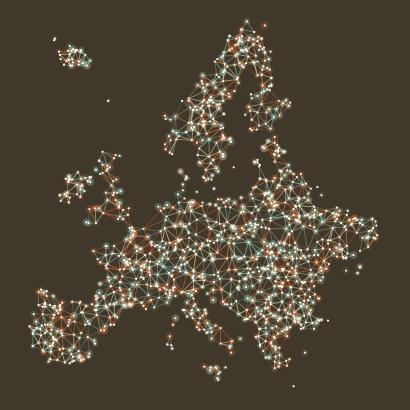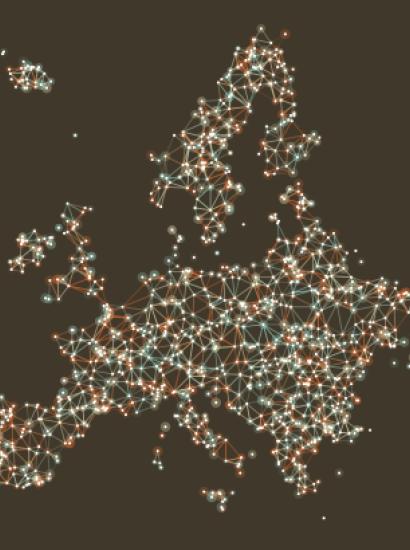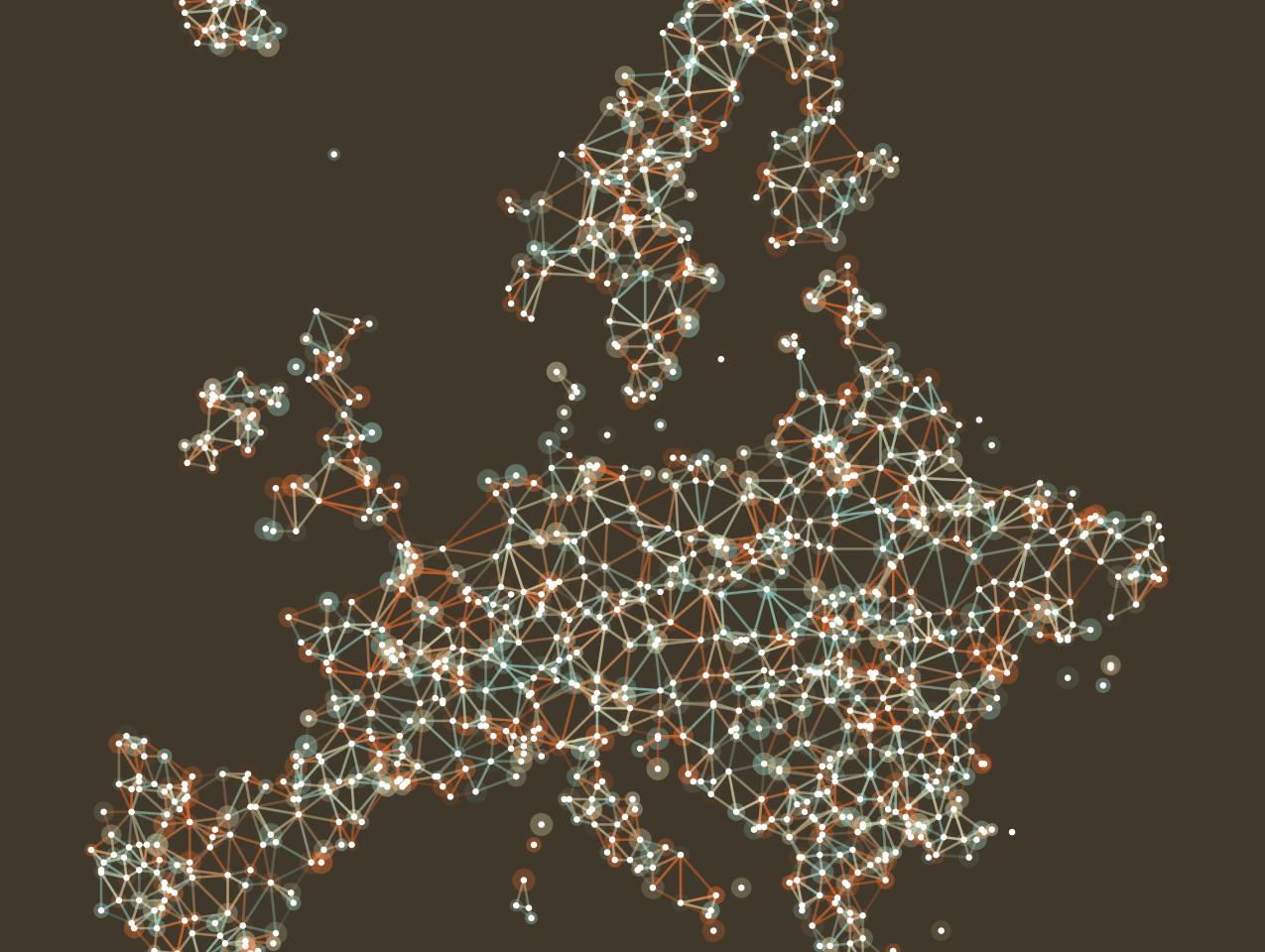After sparking two world wars that brought horrific destruction to its own ancient civilizations, Europe finished the 20th century riding a wave of economic and political success. With decisive economic, political, and military support from the United States, the 15 countries that would form the European Union had rebuilt themselves and helped the United States prevail in the Cold War. They gradually would welcome 13 more countries into their organization, which became widely seen as a pathway to prosperity and a guardrail against the embittered, competing nationalisms that had led to war. Some members of the EU even adopted a common currency, in part to emphasize the benefits of nations working together through economic cooperation rather than trying to dominate each other.
Today, Europe continues to exercise significant power in global trade and international politics. But the sweeping technological change of the last two decades—change that is led even within Europe by outsiders—has shaken European confidence. The technological revolution’s threat to established employment patterns and social order joins threatening demographic trends and volatile immigration flows to turn reborn nationalism into a new, destabilizing force in European politics. These fresh vulnerabilities also deepen concerns created by the globe’s changing climate and the decline of U.S.-Russian cooperation in limiting nuclear weapons.
While much has changed in this emerging new world, this reality remains: Europe continues to be the meeting ground of the world’s most important power rivalries, be they geographic, technological, or ideological. The nature of those rivalries is changing, and expanding, in increasingly unstable fashion. The European Union’s divided system of governance—in some ways an asset during the Cold War—is coming under severe strain in this new era.
The number of American and Russian tanks and missiles deployed along European frontiers was once judged as the decisive marker of geopolitical power. The last act of the Cold War turned on the American decision to deploy Pershing missiles in Europe to counter Soviet SS-20 intermediate range rockets. Today, U.S. and Chinese corporations compete to gain control of technological assets and dominate markets while forging new political alignments in Europe, where Chinese investment in and loans to NATO members—such as Italy and Greece—have helped create political support for Beijing’s Belt and Road strategic initiative. Russia meanwhile has adopted a relatively cheap weaponization of disinformation through digital platforms to weaken the resolve and cohesion of NATO, while investing in updating its conventional and nuclear arsenal.
These rivalries are upsetting alliance management habits and leaving Europeans feeling “like bystanders, overtaken by events directed by others,” in the words of Jens Südekum, a leading European research scientist. French President Emmanuel Macron puts the same thought bluntly. Europe, he says, “needs a Sputnik moment”—a wake-up call that brings new resolve and dedication to excel in science and technology.
These are some of the notable ideas aired in four research papers and a day of roundtable conversation on Europe generated by the George P. Shultz Project on Governance in an Emerging New World. Like the other regions surveyed by the Shultz Project, Europe has had to contend with a technological revolution that has spread around the globe in ubiquitous and instantaneous fashion, leaving governments and other institutions scrambling to keep pace. In some areas, the European experience has provided examples to be followed. In others, failure or inaction has been the dominant European response.
Russia’s decision to use cyber platforms to undermine democratic governments in Europe (as well as to meddle in the 2016 U.S. election) also reflects a major transformation of global power politics. “The important conflict today is centered within states, rather than pitting states directly against each other,” added one roundtable participant. What modern-day American Firsters “say about nationalism is similar to what guys in Hungary, Italy, or Russia say about that subject.”
Digital Challenges from Russia, China, and the United States
Social media has played an outsized role in fracturing national unity and undermining traditional political parties and parliamentary governance in the world’s democracies. Political parties in Europe have also been hollowed out as primary sources of fund-raising and event organization. This is seen as clearly in the debilitating debate over Britain’s referendum-mandated exit from the European Union as it was in the 2016 presidential election in the United States.
In such cases, it was noted, Russian President Vladimir Putin was not “handicapped by a respect for the truth.” This helped his generals to exploit “a grey zone” of information warfare and develop doctrines to guide this “hybrid” form of conflict in Europe, while Washington and its allies in the North Atlantic Treaty Organization (NATO) have been slow to share information or develop joint responses to possible cyber attacks on national or alliance power grids and other forms of infrastructure, in the collective judgment of the participants in the Shultz project discussions. “We have not yet developed even an implicit form of the Mutually Assured Destruction doctrine to protect ourselves,” said one participant.
Russia has called attention to the creation of a new branch of its military that is dedicated to information warfare, William Drozdiak notes in his paper covering the effect of social media, advanced technologies, and artificial intelligence in Europe. Moscow appears to have unleashed these units to stir trouble among Russian populations in Latvia and Estonia, as well as meddle in British, U.S., and German elections. President Macron’s suggestions that NATO and Russia take the lead in working out an international cyber code of conduct have not been taken up by these or other nations. Countering the current cyber threat to elections is as much a governance problem as it is a technological one, with discussants noting the general successes in avoiding disruption had by an organized France in 2017 and by the United States in 2018.
Russia has not in fact developed significant digital platforms of its own. It has instead adapted Western platforms to its (largely subversive) purposes, at relatively low cost. The cost factor is important for the economically weakened regime of President Putin. It is likely Russia will now concentrate more than it has on artificial intelligence and combine it with social media platforms to create “deep fakes”, using falsified photos as well as text. Putin, it was said by one expert on Russia, sees himself as the leader of a growing “illiberal internationalism” that reaches out to nativist political forces inside European nations. He seems to have convinced himself that Western intelligence agencies pioneered the use of information warfare by social media in Ukraine in 2013, and that he is simply paying them back.
These reinforcing technological, demographic, and political changes arrive at a time when NATO, the most successful multinational alliance in history, is experiencing intense internal strains as well. The Trump administration’s America First policies have intensified Europe’s long-held fears of U.S. isolationism, while Trump’s Washington sees major European powers as free-loading parasites that must be forced to change their ways. Until now, Europe has been seen as a force multiplier for American strategic objectives in the protection of common values. But U.S. bases on Russia’s perimeter do not in themselves protect allied interests against cyber operations. A major reappraisal of the nature of the American-European partnership would be occurring now even without the America First political turn.
U.S.-European relations are also perturbed by China’s insistent push to make its technology dominant in European markets and to acquire key infrastructure assets such as a port outside Athens (acquired as payment for loans), infrastructure projects in Portugal (sold to China for $12 billion needed to pay off European creditors), and industrial technology firms based in Germany (though the sale of one tool maker was finally blocked by Berlin). American fears that Chinese technology will be at the heart of Europe’s development of 5G telephone networks led to threats from Washington to stop sharing intelligence with Britain and others European nations if they used the Huawei corporation’s cheaper 5G network equipment.
The third outside power preoccupying Europe’s leaders is none other than the United States. America’s tech giants have in European eyes smothered the chances of Europe to develop its own national champions. And the Trump administration’s disruption of negotiations for a Transatlantic Trade and Investment Partnership, a favored project of German Chancellor Angela Merkel, have left the allied nations without a clear framework for future dealings on advanced technologies.
Economic Causes and Effects
Rather than encourage their companies to compete directly with Facebook, Google, Amazon, and others, European governments have chosen to regulate and tax American tech firms. Regulation and rule-making are part of the EU’s DNA, and these attributes have hampered the Union’s efforts to build a Single Digital Market for its 500 million inhabitants. Despite years of discussion among bureaucrats in Brussels, there continues to be no appealing way for consumers in Italy to buy French goods online, and language is a hurdle for information exchange. Only a unified digital market could provide the kind of scale and financial clout that have helped American and Chinese tech giants grow ever bigger. Of the world’s top 20 digital companies, none are European. Of the top 200, only 8 are, experts at the conference observed.
The division of responsibilities and powers between national governments and the supranational structure of the European Union creates a unique blend of strengths and weaknesses in dealing with such startling change. So does the force of Europe’s diverse and deeply entrenched cultural patterns of behavior and attitudes, which makes disruption a far less welcome force than might be the case in Silicon Valley. Also, the European Union is in large part a political creation formed through the adoption of rules, standards, and other bureaucratic imperatives.
Europeans have also demonstrated a greater attachment to tradition and to privacy than have Americans when it comes to new technology. When Google sent cars around Germany with cameras to map streets without advance notice, German citizens vociferously objected. Digitalization of literature created an uproar in France.
Moreover, established businesses and sources of finance have a shared vested interest in making it difficult for newcomers to compete and prosper, Caroline Atkinson pointed out in her research paper. An initial failure is not forgiven or overlooked in Europe as easily as it is in other societies. Many European would-be entrepreneurs migrate to Silicon Valley, which counts some 60,000 Russian citizens as residents. Venture capital is not an important source of investment in Europe. In Russia, the defense budget is by far the major source of spending on technology.
Europe has seen more traction in its efforts to apply antitrust standards, and to enact corporate codes of privacy such as its General Data Protection Regulation (GDPR). GDPR has been accepted by many of the large American firms, but discussants pointed out that doing so may simply be in tech incumbents' best interests given the cost and technical complexity of compliance for smaller firms. Early efforts at regulating tech have had unexpected dynamics, and European regulators could learn from these experiences. EU members have so far found it easier to limit the role of political advertising in traditional and social media than is the case in America.
Another bright spot is that the generous European safety net facilitates acceptance of disruptive technologies into the workplace. European employers have limited the fallout from the introduction of automation into manufacturing, which occupies a larger role in the overall economy than do services, the reverse of the American pattern. Rather than lay off excess workers, European companies tend to keep them on the payroll while retraining them for different jobs—often in the services sector. This is made possible by general educational practices such as those enshrined in Germany’s apprentice system, which balances occupation-specific training with general education courses that are partly subsidized by the government. The value of this general education foundation may be a surprising finding to many Americans, who are generally more focused on reproducing the (also successful) applied training aspects of apprenticeship models. This pattern does, however, exert a downward pressure on wages, meaning that EU countries today have record high employment rates, and relatively stagnant wages.
By 2018, German industry had installed 8 robots per 1000 workers, compared to a Europe-wide average of 4 per 1000 workers. The comparative U.S. figure was 2. Jens Südekum reported that each U.S. robot installed replaced 3 or more American workers. Germany’s manufacturing sector had lost 200,000 jobs but this loss was offset by an equal job increase in services. It is unclear if that equilibrium can be maintained as artificial intelligence begins to play a larger role in German manufacturing.
Discussion also explored the role of additive manufacturing—popularized under the label of 3D Printing—in reshaping Europe’s role in the global supply chain system of manufacturing that has become the key instrument of international trade during the era of globalization. EU firms, like American ones, heavily offshored industrial production in the 1990s. Now customers demand specialized products, which are not well suited to distant mass production. So far, shifts in this direction are small in the context of the overall supply chain, but they are moving quickly. A fully automated manufacturing facility Adidas has established in Bavaria is being closely watched in Germany as a possible harbinger of a move toward reshoring.
Demographic Realities
Europe is in any event confronting a future in which labor shortages will likely be a more pressing problem than labor surpluses. European countries are setting records for low fertility rates. On current trends, each new generation will be replaced by one two-thirds its size. (Gains in longevity will offset some of these losses, but not significantly.) Without a major increase in immigration, Europe’s population could decline by 100 million in the second half of this century, Christopher Caldwell observes in his report to the conference. But resistance to immigration is growing more intense across Europe as social media fans the flames of cultural and religious animosities and populist parties vow to keep foreigners out.
A prosperous Europe does not control the causes of episodic waves of immigrations aimed at its shores. Wars, deep poverty, and climate change are obvious triggers for mass movements of population. The drying up of Lake Chad was cited as such a cause.
And so are demographic trends. Discussants observed that demographics is another realm in which Europe finds itself an early witness, but with little sense of control. While Europe’s birth rates have declined since the 1960s, Africa’s total population has grown 500 percent to 1.3 billion. The semi-nomadic nation of Niger, which had a smaller population than that of Brooklyn in 1950, will have more people inside its borders than France will in 2050. In short, Caldwell warns Europe has a ticking population bomb on its doorstep. The median age in the EU is 43. In Africa, it is 19. The assimilation of young unaccompanied immigrant males is a growing problem in the squares of European towns, where indigenous children are few, and which have been slow to attract so-called “high value” migrants who possess skills and/or significant wealth.
Conference participants were not united on what steps Europe is likely to take to manage the social disruption that could accompany the growing immigration flows these numbers suggest. Countries like Sweden have welcomed so many immigrants as their native-born citizenry’s birth rates have declined that nearly 20 percent of the population is now foreign-born, Caldwell said.
Cultural assimilation of immigrants into Europe’s established societies has been relatively slow in other countries. “Frontier” countries such as Italy and Greece voice resentment over the numbers of refugees from Syria, Eritrea, and other war-torn societies they have had to absorb in comparison with more geographically removed European countries. But, it was noted, even in Central European countries with relatively few migrants, public opinion polls show fear of and/or hostility toward refugees growing. The growing demand to move to Europe—it was noted that a Gallup survey shows 700 million adults around the world saying they want to move somewhere else, with 23 percent naming Europe as their preferred destination—is in sharp conflict with growing resistance to accepting immigrants. There was also no general agreement on whether there is clear evidence of a strong link between immigration and crime in Europe.
There was, however, a general sense that the growing diversity produced by social media, advanced technology, and global immigration and demographic patterns presents the world with a governance challenge that can be satisfactorily managed by the democratic institutions of America and Europe if attention is paid and creative thinking applied. Caldwell argued that Europe has not treated the problems with either attention or creativity. Instead, the default position of European populations has been to expect the newcomers to adopt the host population’s values and habits automatically, or to be satisfied to live in sordid isolation in ghettoes on the edges of big cities. European governments have done relatively little to educate potential refugees and economic migrants before they leave Africa or other points of departure about what awaits them and how their behavior will be expected to change in public settings in particular. The preponderance of young male immigrants—and the growing lack of native-born young males—adds to the problem of social tensions and perceptions of sexual harassment, one participant argued.
Uneducated and untrained immigrants will find it difficult to take advantage of Europe’s institutional assets, such as the German apprentice worker system. Europe therefore has significant incentives to direct development aid and other forms of educational assistance to potential immigrant groups, it was suggested, with goals of either better preparing those who do leave for life in their new countries of residence or equipping them to stay where they are and prosper.
But that must be done with care. When President Macron of France touched on greater educational opportunities for women being a crucial step toward reducing fertility rates, he was criticized in Africa and elsewhere for at a minimum being patronizing toward Africans. Macron’s predecessor, Charles de Gaulle, once observed that geography is history. The sense from the discussion was that demography is Europe’s future, for better or for worse.
Jim Hoagland is an Annenberg Distinguished Visiting Fellow at the Hoover Institution and has served in a variety of reporting, editing, and opinion-forming roles at the Washington Post since joining the newspaper in 1966. Winner of two Pulitzer Prizes and other journalism honors, he became a contributing editor to the Post in January 2010, after serving two decades as associate editor and chief foreign correspondent.
















